Akhenaten (aka Akhenaton) is one of Ancient Egypt's most controversial and notable pharaohs. He ruled for 17 years during the 18th Dynasty and came to be known by some fascinating names, including Great Heretic, The Heretic Pharaoh, and Rebel Pharaoh. Originally, he was known as Amenhotep IV, but then changed his name to reflect his link with the new supreme deity, whom he worshiped.
Akhenaten's Famous Family Tree
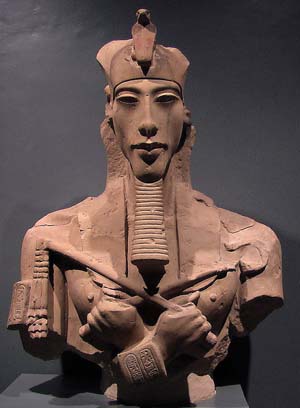
© kairoinfo4u - Statue of Akhenaten
King Akhenaten was born to Amenhotep III and Queen Tiye. Akhenaten's wife is believed to have, at the very least, been a relative and most likely his half-sister, Nefertiti. It was a common, and expected, tradition among ancient Egyptian pharaohs, for the ruler to marry the eldest daughter of his father.
Some believe she was only 12 when she married Akhenaten. Regardless of her relation to him, Nefertiti, is famous in her own right and famed for her beauty. While the pharaoh had other wives as well, depictions found inside temples indicate that Nefertiti was without a doubt his chief wife, at least for twelve or so years. The king eventually elevated Queen Nefertiti to divine status.
Queen Nefertiti bore six daughters for King Akhenaten, while two sons, including the famous King Tutankhamun, are believed to be born to the Pharaoh and one of his sisters. The other son, Smenkhkare, was crowned co-regent at only 16 years of age. King Tut was crowned King at the tender age of 8 or 9.
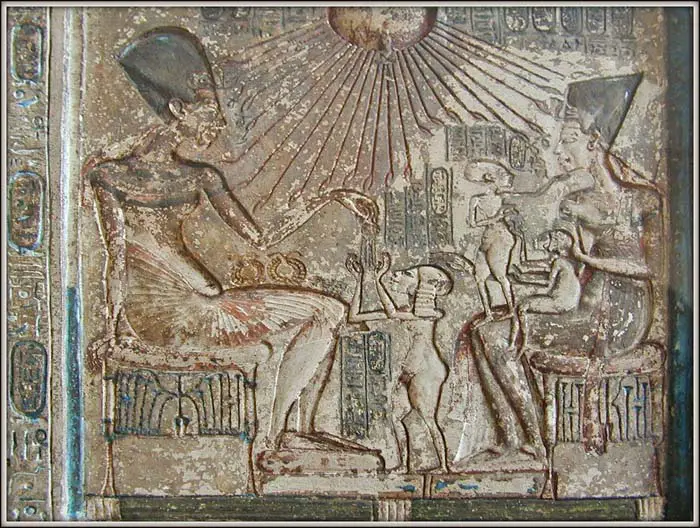
© Jean-Pierre Dalbéra - Depiction of Akhenaten and his family
Akehnaton's parents were Amenhotep III and his Chief Queen Tiyee. Akehnaton succeeded to the thrown after his father's reign of 38 years and his subsequent death, only because Akehnaton's older brother had died of unknown and mysterious causes. Scholars have surmised that Akehnaton as a child was shunned by most of his family and the public. He never received any honors and never appears in family portraits or was taken to public events. His mother, Queen Tiyee, however, favored him, which may have helped elevate him to the ultimate status he enjoyed.
King Akhenaten's Possible Illness
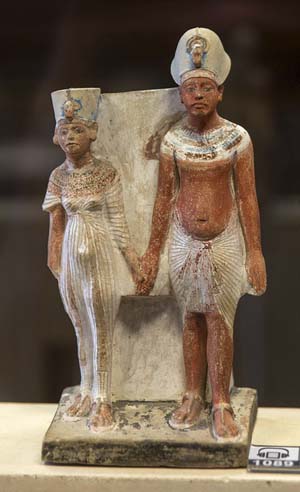
© kairoinfo4u - Akhenaten and Nefertiti
It is widely believed that King Akhenaten had an illness called Marfan's Syndrome. Today, Marfan's Syndrome affects about one in 5,000 people and is a genetic disorder that involves the body's connective tissue. Depictions of the king and his family reveal that they displayed some of the symptoms of Marfan's Syndrome. Symptoms include an elongated head, neck, arms, hands and feet, a pot belly and heavy thighs, poor muscle tone and a short torso. The illness tends to make people very tall and many die at an early age because of weakened aortas that are prone to rupture.
However, the King may have suffered from other illnesses. Other possibilities include Froelich's Syndrome, however, unlike Froelich's Syndrome, Marfan Syndrome does not result in lack of intelligence or sterility. It is also possible that the King suffered from no illness at all, and simply pioneered a new trend in art.
King Akhenaten is the first Pharaoh to insist that sculptures, paintings and other depictions of him and his family be real depictions instead of the strong, muscular-looking depictions of pharaohs in the past. The innovative depictions gave the artists of the time freedom to portray the royal family in real-life events, something that had never happened before.

© sebi - Akhenaten's Tomb
Akhenaten and his Noteworthy Accomplishments
Despite being cast out of society and his family as a child, Akhenaten is considered to be one of the world's most important religious innovators. As one of Ancient Egypt's most controversial and influential pharaohs, Akhenaten's early reign was a time when Egypt prospered. He lived at the peak of Egypt's imperial glory when it had never been richer, more secure or more powerful.
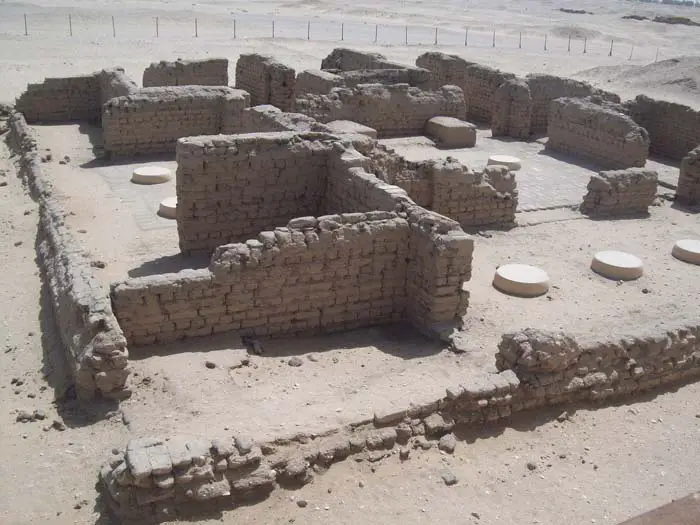
© isawnyu - Ruins at Amarna
- Started a Monotheistic Religion
The Heretic King is believed to be the first person to promote a monotheistic religion, the belief in only one god. He claimed, There is only one god, my father. I can approach him by day, by night. The king wrote about being visited by beings that came from the sky, and the ancient Egyptians worshiped him as a god, believing he was a direct descendant of Aten, the disc of the sun. This was known as Atenism. It has been suggested that Akhenaten was actually the founder of the Judeo-Christian religion. Sigmund Freud argued that Moses was an Atenist priest who had been forced to leave Egypt with his followers after the Heretic King's death. Freud believed that Moses achieved the monotheism that Akhenaten sought to promote.
- Worship of Aten
Like no other Pharaoh before him, he abandoned the traditional Egyptian polytheism and started worship centered on Aten, God of the solar disc. This happened during the sixth year of his reign, and he ordered all of the icons for gods other than Aten removed. It was at this time that he and his royal family moved from Thebes to Amarna, where the king lived for ten years.
- The Great City of Amarna
At its peak, Amarna boasted 10,000 citizens. These citizens were priests, traders, artisans, boatmen and their families. Amarna spanned many miles across the desert. Elegant palaces, statues of Akhenaten, decent housing and the widest road the ancient world had ever known made up Amarna. The road was built to accommodate chariot processions.
- Promoted Realistic Art
Likely suffering from Marfan's Syndrome, the king demanded that artists portray him and his family in their true sense, with sunken eyes, long necks, potbellies, weak, etc. His daughters had a 50/50 chance of being born with Marfan's Syndrome and were depicted with the affliction as well.
Troubles During Akhenaten's Reign
- Decline of Imperial Glory
Unfortunately, during the king's reign much of Egypt's imperial glory started to decline. During his reign, he slowed Egypt's military defenses and stopped foreign military campaigns. His religious beliefs differed from traditional ancient Egyptian religious beliefs. He and his family moved from Thebes to Amarna, a city he built in dedication of the sun god he worshiped. While in Amarna, the conditions in Egypt declined. He neglected foreign policy and allowed territories to be taken. Being in Amarna and not the capitol city pushed him farther away and isolated him from his people's problems.
- Many Egyptians didn't agree with his Religious Beliefs
Even though Amarna was a prosperous and beautiful city, many ancients living there did not accept the monotheistic religion that Akhenaten promoted. They were reluctant to accept one god as opposed to the hundreds that they were used to worshiping. Their old gods were tangible and viable, whereas Aten which is essentially, light, was too ethereal a concept for them to grasp. The ancient Egyptians also began wondering about the stability of their afterlife, since the old gods were not being worshiped.
- The New Religion Weakened the Economy
After the royal family moved from Thebes to Amarna and declared all other gods besides Aten non-existent, many ancient Egyptians saw their livelihood diminish and went out of business. In ancient Egypt, religion was a popular means to making a living, and many who did were out of luck. These people were scarab makers, wood carvers, and others.
Akhenaten's Royal Tomb
Referred to as Tomb 55 in the Valley of the Kings, and also The Royal Wadi at Amarna, Akhenaten's royal tomb was found in the late 19th century. The tomb's construction began around 1344 BC and was completed during Akhenaten's reign. His tomb generally reflected other standard tombs in the Valley of the Kings at the time, with the exception of having additional burial chambers for other members of Akhenaten's family. It also contained a straight main hallway, while in all other tombs the main corridor always had turns. Although a pink sarcophagus was found inside the tomb, with Nefertiti extending her protective arms at the corners, no actual mummy was found inside. The whereabouts of King Akhenaten's remains is a mystery even today.
The Royal Tomb consists of these structural features:
- Entrance Stairway
- Straight Main Corridor
- Well Shaft
- Three additional burial chambers, alpha, beta, gamma
- Unfinished chambers
- Well Shaft
- Akhenaten's Burial Chamber
Akhenaten's Royal Tomb was plundered and most of the objects inside destroyed. Some of the objects found inside the Royal Tomb were fragments from two sarcophagi along with their lids, pieces of an alabaster Canopic chest, and two hundred shabti-figures. Canopic chests contained the internal organs of the deceased once removed. This happened during the process of mummification. Shabti figures acted as servants upon the king's death, to help them throughout the afterlife.
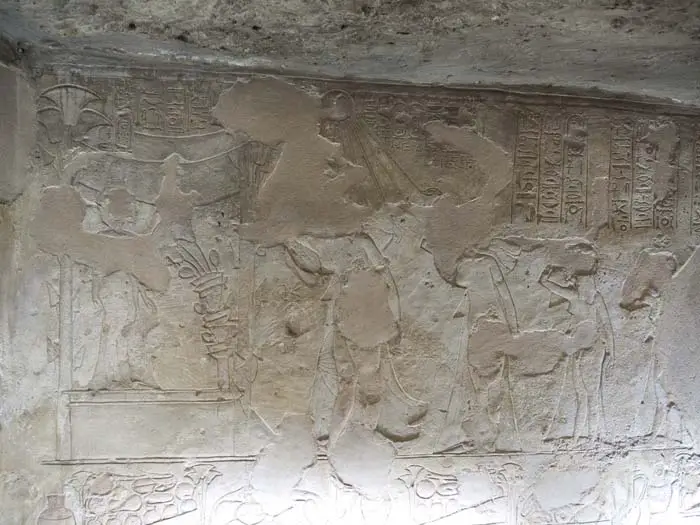
© kairoinfo4u - Depictions at Akhenaten's Tomb
Depictions found on the Walls of the Royal Tomb:
- The Royal family is depicted worshiping Aten in a temple while the sun sets, courtiers are below
- Seven scenes of foreigners with their arms raised in adoration of Aten
- Nine scenes depicting soldiers and chariots some of the horse's heads are depicted from front view, which is unusual
- The Royal family depicted worshiping Aten in a temple while the sun rises, chariots and attendants are outside of the depicted temple
- A visual portrayal of the Hymn to the Aten. It is the longest hymn-poem and is attributed to Akhenaten.
- A scene of the King and Queen mourning who is believed to be their daughter, Princess Meketaten
- A depiction of the dead princess on a bier with two other princesses mourning over her
- In the third chamber, there are many scenes depicting what appears to be Princess Meketaten dying during childbirth. It is uncertain if Meketaten died or if one or more of her sisters died during childbirth. Akhenaten was likely the father in his desperation to produce a male heir.
The Amarna Letters
The Amarna Letters consist of diplomatic communications. This correspondence is a collection of messages on clay tablets that were sent to King Akhenaten by various outpost and foreign rulers. It is clear through the Amarna Letters that the Heretic King turned his nose up at the Egyptian territories and did not supply them with gold or forces. Due to the King's indifference, the country's power and prosperity began to decline.
Polytheism Resurfaces After Akhenaten's Death
Smenkhkara succeeded Akhenaten for a short time after his death. Smenkhkara and Akhenaten's oldest daughter were married. After Smenkhkara's reign, King Tut came into power at just eight years old. When King Akhenaten died, the priests of Amun were eager to gain back religious control. The Egyptian people wanted their normal lives back as well. When King Tut came into power, Amarna had been abandoned and the capital city was now Memphis.
At this time, all traces of Akhenaten and his heretic religion were erased. The king's name was even removed from all official king lists. His many temples were taken apart, and the stone re-used for other projects. The once great city of Amarna was left to lie in ruins in the desert.
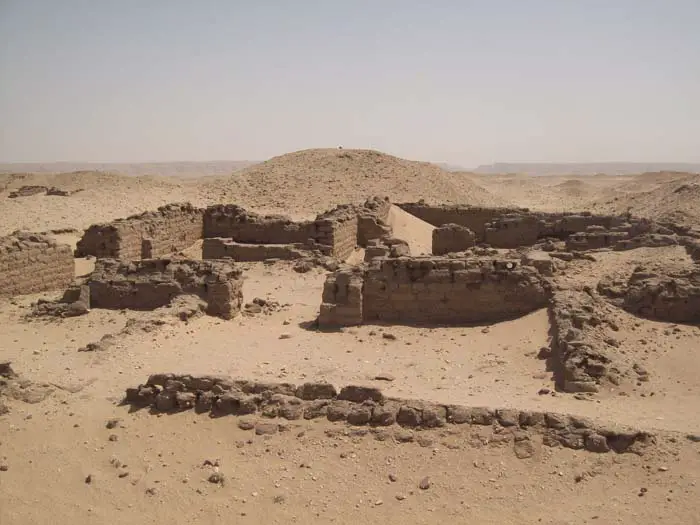
© Isawnyu - Amarna Central City Ruins
Interesting facts about Akhenaten
- Although born Amenhotep IV, he changed his name to reflect his personal closeness to the supreme deity, Aten, through his new name, Akhenaten.
- Originally outcast from most of his family and society, Akhenaten only succeeded his father's throne because of the untimely and mysterious death of his older brother Thutmose.
- The Heretic King's mummy has never been found. It remains an archaeological mystery to this day.
- It has been suggested that Akhenaten may have been the very first monotheistic in the history of the world. Judeo-Christian monotheism sprang from Akhenaten's beliefs.
- His father, Amenhotep III reigned for 38 years. During the 37th year, Akhenaten was co-regent with his father.
- Akhenaten died during the 17th year of his reign.
- He is one of the most controversial pharaohs. He is noted for abandoning polytheism which had been in place for thousands of years, and introducing a religion centered on worshiping just one god.
- He married Queen Nefertiti, one of the most beautiful and well-respected women in ancient Egyptian history. Many historians believe she was 12 years old at the time.
- Through DNA testing, it has been proven that King Akhenaten was the father of King Tutankhamun.
- King Akhenaten likely suffered from an illness called Marfan's Syndrome. Other possibilities have been suggested including elephantiasis and Froelich's Syndrome.
- During the Amarna times, plague spread through Egypt that brought famine and disease. It killed thousands and was the first ever recorded instance of an influenza epidemic.






